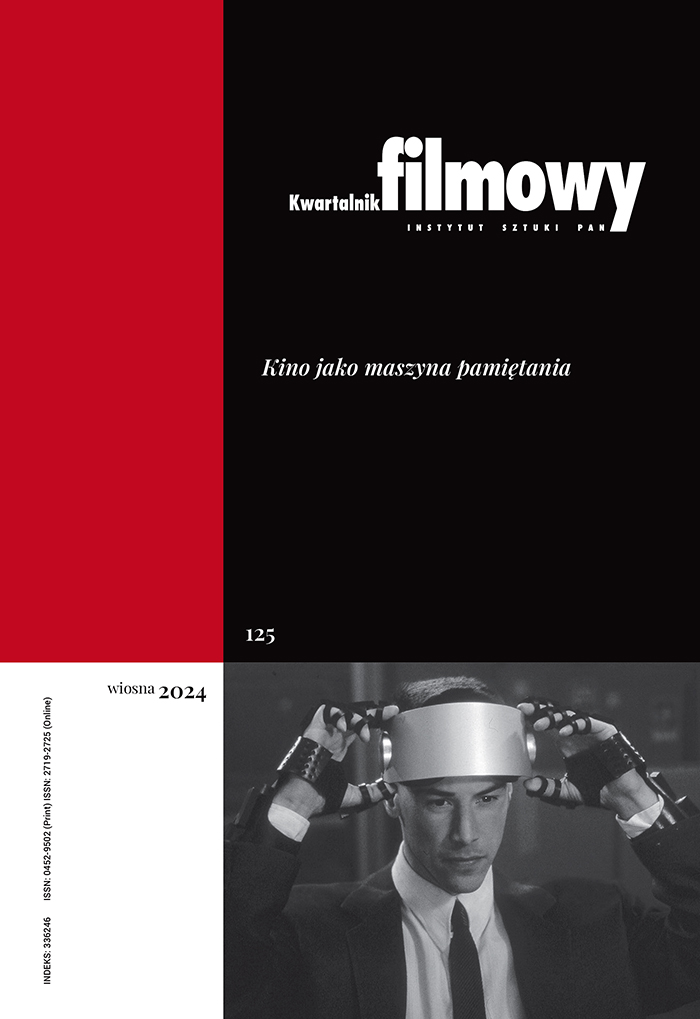Zen in Cinema
Abstract
Writing on the relationships of Western experimental film, especially abstract images, with the philosophy and aesthetics of the Far East, Giżycki asks the question: Does... animation, the art of slowly adding small changes to a single frame, derive much from Oriental contemplation at all? Giżycki discusses works of Korean artist Nam June Paik, one of video art pioneers, who „made” Zenfor Film ; of James Whitney, the director of Yantra (1950-55), Dwija (1976), Wu Ming (1970-77), Hsiang Sheng (1977), Kang Jing Xiang and Li (the last two ones unfinished); of Jordan Belson whose inspiration by the culture of the Orient can be found in the titles of his abstract films: Mandala (1953), Raga (1959) or Samadhi (1967); of Robert Breer, influenced by the Japanese drawings of Katsushik Hokusai (views of Mount Fuji) and of film maker-abstractionist David Ehrlich, who thinks that a sense of time with which he makes films is closer to the culture of the Orient than to the culture of America.
Keywords:
animation, Nam June Paik, experimental cinema, David EhrlichReferences
Nie dotyczy / Not applicable
Google Scholar
Authors
Marcin Giżyckikwartalnik.filmowy@ispan.pl
Rhode Island School of Design United States
Krytyk i historyk sztuki, autor książek z dziedziny historii filmu i zjawisk kultury artystycznej. Wykładowca w Rhode Island School of Design w USA. Prorektor w Warszawskiej Wyższej Szkole Sztuk Audiowizualnych i Nowych Mediów. Opublikował m in. Nie tylko Disney - rzecz. o kinie animowanym (2000), Koniec i co dalej? (2001), Słownik kierunków, ruchów i kluczowych pojęć sztuki drugiej połowy XX wieku (2002).
Statistics
Abstract views: 1064PDF downloads: 138
License
Copyright (c) 2005 Marcin Giżycki

This work is licensed under a Creative Commons Attribution 4.0 International License.
The author grants the publisher a royalty-free non-exclusive licence (CC BY 4.0) to use the article in Kwartalnik Filmowy, retains full copyright, and agrees to identify the work as first having been published in Kwartalnik Filmowy should it be published or used again (download licence agreement). The journal is published under the CC BY 4.0 licence. By submitting an article, the author agrees to make it available under this licence.
In issues from 105-106 (2019) to 119 (2022) all articles were published under the CC BY-NC-ND 4.0 licence. During this period the authors granted a royalty-free non-exclusive licence (CC BY-ND 4.0) to use their article in „Kwartalnik Filmowy”, retained full copyright, and agreed to identify the work as first having been published in our journal should it be published or used again.
Most read articles by the same author(s)
- Marcin Giżycki, Smartphone – The Triumph of Eisenstein , Kwartalnik Filmowy: No. 112 (2020): Polish Documentary, Polish Animation
- Marcin Giżycki, … Only Stills Remained: Nonexistent Films of Cindy Sherman , Kwartalnik Filmowy: No. 115 (2021): Form Film, Content Film
- Marcin Giżycki, „L’âge d’or” – the Masterpiece of Provocation , Kwartalnik Filmowy: No. 109 (2020): Architectural Space in Film
- Marcin Giżycki, The Last Wizard of Western World , Kwartalnik Filmowy: No. 34 (2001): Cinema at the Turn of the Century
- Marcin Giżycki, Why I Do Not Like Advertising in the Cinema , Kwartalnik Filmowy: No. 105-106 (2019): Cinema and Political Transformation
- Marcin Giżycki, Expanded Cinema Thirty Years Later , Kwartalnik Filmowy: No. 35-36 (2001): Cinema and New Media
- Marcin Giżycki, The Highs and Lows of Animation in Bohemia , Kwartalnik Filmowy: No. 81 (2013): Child in Film
- Marcin Giżycki, The Revenge of Joker and Parasites , Kwartalnik Filmowy: No. 108 (2019): Film Production and Distribution
- Marcin Giżycki, The Magical Beginnings of Cinema , Kwartalnik Filmowy: No. 74 (2011): Film Objects
- Marcin Giżycki, The Artist in a Haunted House: Jeremy Blake and the Winchester Mystery House , Kwartalnik Filmowy: No. 97-98 (2017): Wandering Motifs











